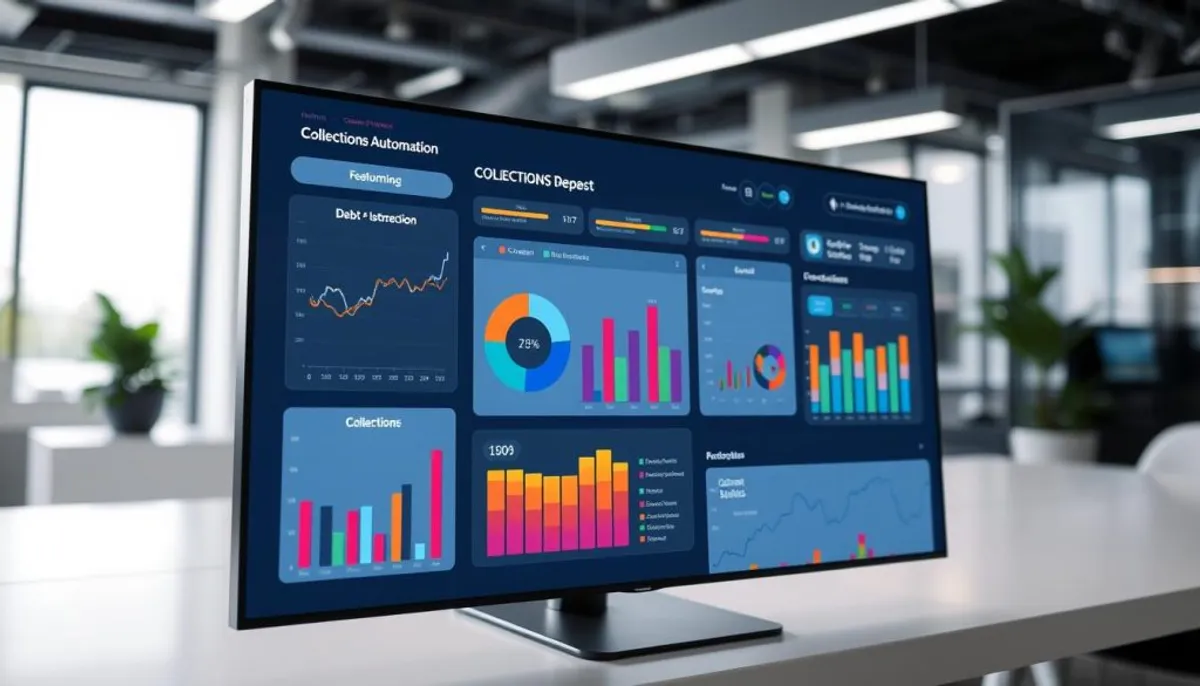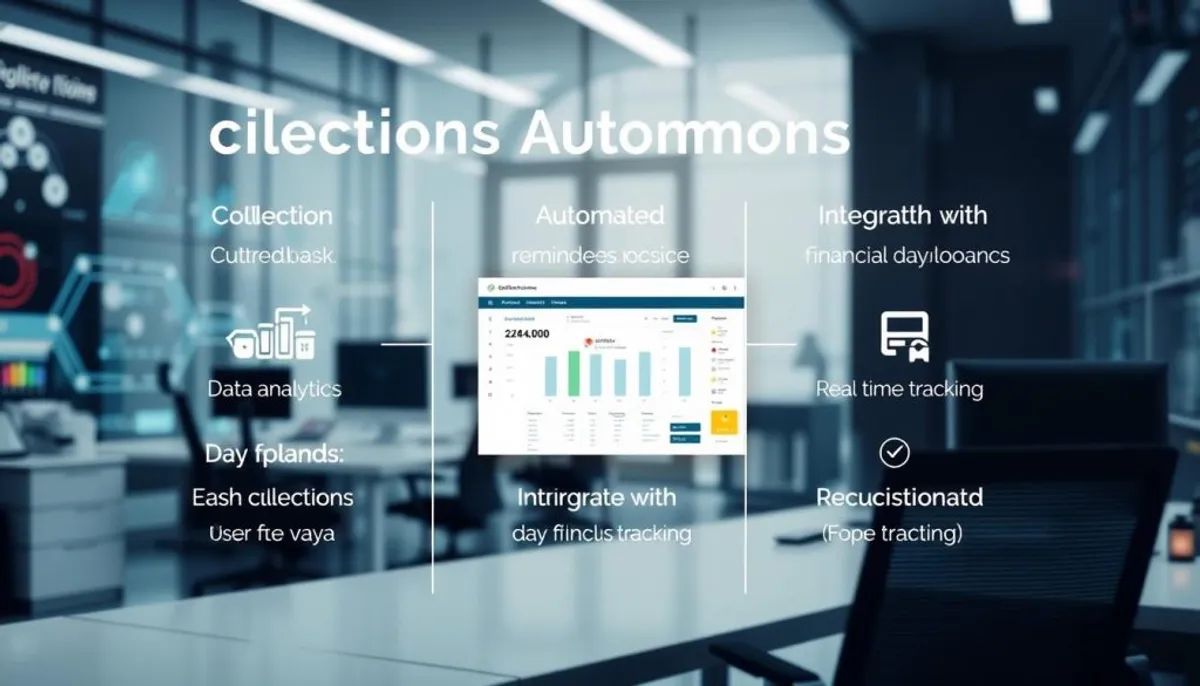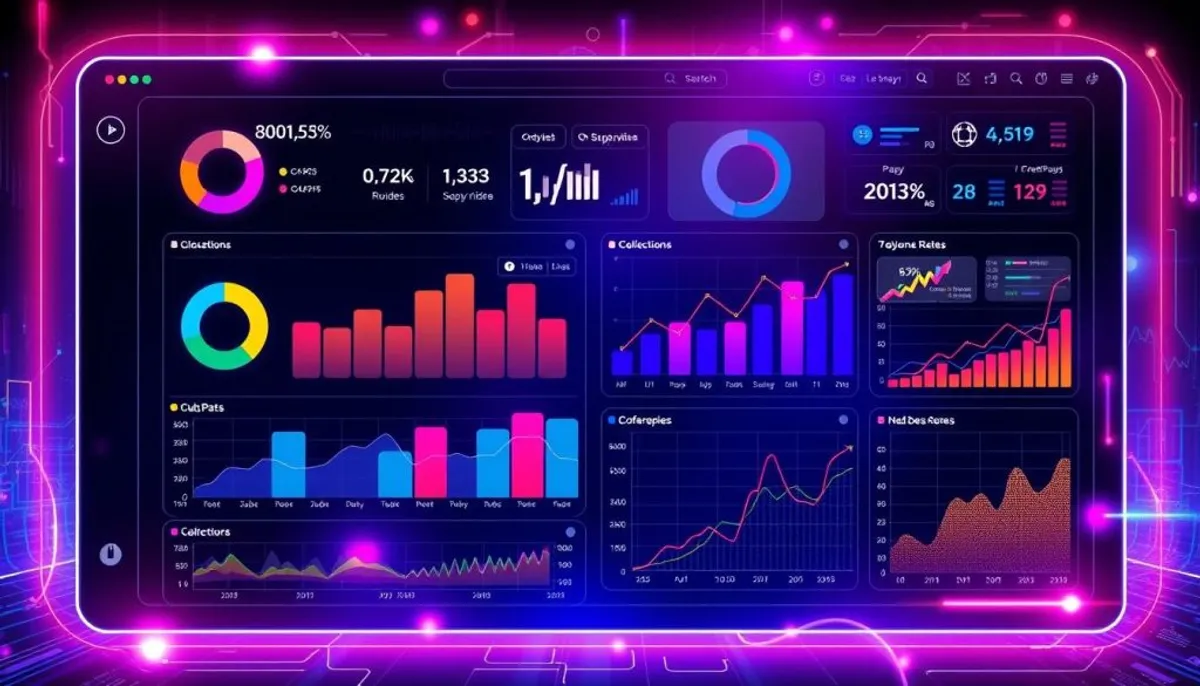In today’s fast-paced financial world, collections automation is revolutionizing debt recovery processes. This cutting-edge technology empowers finance teams to boost efficiency and recover payments faster. By integrating advanced accounts receivable management tools, businesses can significantly improve their cash flow and reduce past due accounts.
Debt recovery software leverages artificial intelligence to analyze customer data, prioritize accounts, and predict payment behavior. This smart approach allows collectors to focus their efforts where they’re most needed, leading to impressive results. Many companies have reported substantial improvements in productivity and reductions in overdue amounts within months of implementation.

The power of collections automation extends beyond just improving recovery rates. It also enhances team productivity through automated workflows, one-click calling systems, and AI-driven communication strategies. These features enable finance teams to handle a larger volume of accounts with greater precision and less manual effort.
Key Takeaways
- Collections automation software can lead to a 20% reduction in past due accounts
- AI-driven prioritization analyzes over 20 variables to allocate accounts effectively
- Automated systems can increase productivity by up to 40% within 6 months
- Advanced software solutions offer 4 times weekly past-due coverage
- Generative AI helps compose responses, boosting efficiency by 30%
- Automated cash posting can reach 82%, eliminating lockbox fees
- Customizable views allow for easy prioritization of high-risk customers
Understanding Modern Collections Automation Solutions
Collections automation has transformed debt recovery technology. These advanced systems combine invoice processing automation and payment reconciliation tools. This integration streamlines operations, marking a significant leap forward in the collections industry.
Key Components of Automated Collection Systems
Modern collection systems feature several essential components:
- AI-driven customer prioritization
- Automated email campaigns
- Integrated communication tools
- Collections workflow optimization
Benefits of Digital Transformation in Collections
The transition to digital has introduced numerous benefits:
- 4x increase in weekly past due coverage
- 2x boost in collection calls
- Enhanced accuracy by reducing human error
- Improved cash flow management
- Better customer experience with easy payment options
Automated systems expedite payment processing, leading to faster transactions. They also provide detailed reporting and analytics, offering crucial insights for decision-making. By adopting these solutions, businesses can enhance their competitive edge while ensuring compliance with regulations and safeguarding data.
The Power of AI in Debt Recovery Management
AI is transforming debt recovery, revolutionizing how we prioritize customers, predict payment behavior, and optimize strategies. The global debt collection software market, valued at $4 billion in 2022, is projected to reach $7.4 billion by 2028. This growth is expected at a CAGR of 10.91%.
AI-Driven Customer Prioritization
AI systems analyze over 20 variables to effectively prioritize customers. This approach results in a 25% decrease in loan delinquencies and up to 20% reduction in bad debt. Collections analytics dashboards offer real-time insights, facilitating smarter decision-making.
Predictive Analytics for Payment Behavior
Bad debt prediction models forecast payment behavior using 12 months of historical data. This leads to an 18% increase in Promise To Pay rates and a 23% growth in on-call payment share. Dynamic risk segmentation outperforms static models, based on credit scores and missed payments.
Machine Learning for Collection Strategy Optimization
Machine learning algorithms continuously refine collection strategies, boosting overall efficiency by 15%. AI-based solutions reduce debtor coverage costs by up to 70% and increase response rates tenfold. This optimization results in a 20% boost in agent productivity and a 30% drop in compliance-related issues.
| AI Impact | Improvement |
|---|---|
| Promise To Pay Rates | 18% increase |
| On-call Payment Share | 23% growth |
| Time To Collect | 8% reduction |
| Collection Efficiency | 15% improvement |
| Agent Productivity | 20% boost |
Collections Automation: Core Features and Capabilities
Collections automation software brings forth a suite of advanced features to streamline debt recovery processes. These tools significantly boost productivity and refine collections workflows, making them indispensable for contemporary enterprises.
The generation of dunning letters stands out as a pivotal feature. This automated mechanism crafts and dispatches tailored reminders to debtors, thus conserving time and ensuring consistent dialogue. The optimization of collections workflows is equally vital, empowering teams to manage tasks with greater efficiency and to prioritize accounts more effectively.

State-of-the-art systems integrate AI-driven email responses and centralized email management. These functionalities facilitate rapid, personalized communication with debtors while maintaining a unified perspective on all interactions. The inclusion of one-click calling and automated note-taking further streamlines the collection process. This allows agents to concentrate on engaging with customers, rather than being bogged down by administrative duties.
| Feature | ERP Dunning Emails | A/R Collections Automation |
|---|---|---|
| Personalization | Basic | Advanced |
| Data Utilization | Limited | Comprehensive |
| Automation Level | Simple | Advanced |
| Performance Tracking | Limited | Real-time KPI Dashboard |
| Account Prioritization | Manual | AI-driven |
By harnessing these core features, businesses can witness substantial enhancements in their collections processes. Research indicates that the adoption of collections automation can result in a 30% productivity boost. It also enables teams to manage 10 times more customer outreach.
Maximizing Team Productivity Through Automated Workflows
Collections workflow optimization and accounts receivable management have seen a significant advancement with the introduction of automated workflows. These systems enhance team efficiency and streamline operations in remarkable ways.
One-Click Calling Systems
One-click calling systems have revolutionized outbound communication. Agents can now initiate calls directly from the platform, eliminating the need for manual dialing. This seamless integration saves time and reduces errors in customer contact information.
Automated Note-Taking and Transcription
Natural Language Processing powers automated note-taking and transcription. This technology captures call details accurately, freeing agents to focus on customer interactions. The result is improved documentation and more personalized service.
Task Generation and Management
Automated task creation transforms follow-up processes. The system generates tasks based on call outcomes and customer responses. This feature ensures no follow-up falls through the cracks, enhancing accounts receivable management efficiency.
| Workflow Feature | Benefit | Impact on Productivity |
|---|---|---|
| One-Click Calling | Faster outbound calls | 20% increase in call volume |
| Automated Note-Taking | Improved documentation | 30% reduction in post-call work |
| Task Generation | Streamlined follow-ups | 25% increase in successful collections |
By implementing these automated workflows, teams can significantly enhance their collections workflow optimization. The reduction in manual tasks allows agents to focus on high-value activities, improving overall accounts receivable management outcomes.
Smart Communication Strategies in Digital Collections
Digital collections have revolutionized how businesses interact with customers regarding unpaid debts. At the heart of this transformation is collections automation. It streamlines the process by centralizing all collection emails and linking them to customer accounts. This allows for better tracking of open rates and engagement.
Automated systems empower businesses to send timely reminders and focus on high-value accounts. This strategy has been highly effective for many companies. For example, Videotron, a leading Canadian telecommunications provider, achieved a 10% monthly savings increase in debt collection activities through early-stage automation.
Effective communication strategies include the use of dunning letter generation. These automated reminders can be tailored to various scenarios, from initial gentle notices to urgent final reminders. Lexop’s study revealed that 69% of respondents expect digital communications for debt collection. Yet, only 27% were contacted via email or SMS in the telecommunications sector.
| Communication Method | Customer Expectation | Actual Usage |
|---|---|---|
| Digital (Email/SMS) | 69% | 27% |
| Traditional Methods | 31% | 73% |
By adopting collections automation and smart communication tactics, businesses can notably enhance their recovery rates. Videotron saw a 27% increase in self-cure rates and a 11% reduction in third-party agency cases. These outcomes underscore the efficacy of personalized, timely, and digital communication in contemporary debt collection practices.
Leveraging Data Analytics for Better Recovery Rates
Data analytics is revolutionizing debt collection, offering advanced tools to enhance recovery rates. With consumer debt hitting $17.1 trillion in 2023 and credit card delinquency rates exceeding 2.6%, the need for effective debt management is paramount. Collections analytics dashboards have emerged as critical tools in this endeavor.

Real-Time Performance Tracking
Collections analytics dashboards provide real-time insights into recovery efforts. They track essential metrics such as contact rates, promise-to-pay ratios, and overall collection performance. This immediate feedback empowers teams to swiftly adjust strategies, enhancing both efficiency and outcomes.
Custom Report Generation
Advanced analytics platforms offer customizable reporting features. Users can generate tailored reports that concentrate on specific aspects of the collection process. These reports help identify trends, highlight successful tactics, and pinpoint areas for improvement.
ROI Measurement and Analysis
Measuring return on investment is vital in debt recovery. Analytics tools enable precise ROI calculations for various collection strategies. Bad debt prediction models leverage this data to forecast outcomes and optimize resource allocation. By focusing on high-return strategies, companies can significantly reduce operational costs and boost recovery rates.
- Identify high-risk customers through credit score and default rate analysis
- Predict self-cure customers likely to pay without intervention
- Optimize contact times for improved effectiveness
- Allocate staff efficiently based on data-driven insights
By leveraging data analytics, collection agencies can develop more effective, personalized strategies. This data-driven approach not only elevates recovery rates but also enhances the overall customer experience in debt collection processes.
Integration Capabilities with Existing Systems
Collections automation software integrates effortlessly with current finance systems, significantly enhancing efficiency and precision in debt recovery. This integration facilitates seamless invoice processing automation and improves payment reconciliation tools.
By linking with ERP systems, collections automation streamlines operations. It enables automatic payment application, auto-coding of deductions, and eliminates manual tasks. This integration results in substantial cost savings and improved productivity.
- AR automation can cut invoicing expenses by over 70%
- End-to-end automation eliminates 100% of lockbox data capture fees
- Automated cash applications significantly reduce operational expenses
The integration of collections automation with existing systems improves cash flow management. It offers real-time data flow, enhancing process visibility. Self-service portals and online payment options improve Days Sales Outstanding and strengthen customer relationships.
Collections automation also simplifies invoice generation and delivery. It integrates various payment gateways, offering electronic payment options. Automated reminders for upcoming or overdue payments enhance customer communication and reduce late payments.
Automated Email Campaign Management
Collections automation has transformed the management of email campaigns for businesses. It introduces dunning letter generation and smart scheduling, enhancing efficiency and streamlining collection processes.
Template Customization
Modern email automation tools provide customizable templates for diverse scenarios. These templates enable businesses to craft personalized dunning letters and collection notices swiftly. Tailoring messages to specific customer segments can significantly enhance response rates and recovery outcomes.
Scheduling and Tracking
Automated scheduling ensures timely email delivery, based on customer payment behavior. The system automatically sends account status updates and payment reminders. Tracking features offer insights into email performance, aiding in the refinement of strategies for superior results.
Response Management
Collections automation systems excel in managing responses. They categorize incoming messages, prioritize urgent inquiries, and generate automated replies. This approach allows collection teams to concentrate on high-value interactions, while routine matters are efficiently handled.
Utilizing these advanced features, businesses can reach up to ten times more customers through automated email campaigns. This substantial increase in productivity leads to improved recovery rates and a more effective collections process overall.
Compliance and Security in Collections Technology
In 2023, 70% of service organizations faced the challenge of adhering to at least six frameworks for information security and data privacy. This underscores the critical role of stringent compliance measures in today’s digital landscape. The need for robust security protocols in collections automation and accounts receivable management systems is paramount.
Data Protection Measures
Modern collections automation platforms are equipped with cutting-edge data protection features. These features are designed to shield sensitive customer information from unauthorized access and breaches. Encryption, access controls, and regular security audits are integral components of these systems.
Regulatory Compliance Features
Automated debt collection software comes with built-in compliance features to ensure adherence to industry standards. These features assist businesses in navigating the complexities of regulations such as GDPR, HIPAA, and SOC 2. Automated reminders and multi-channel communication tools are crafted to meet legal requirements, thus reducing the risk of costly violations.
Audit Trail Management
Effective accounts receivable management hinges on transparent and accountable processes. Audit trail management features in collections automation systems provide a detailed record of all actions taken. This ensures the accuracy of payment information and enables proactive follow-ups while maintaining compliance. Real-time data and reporting enhance decision-making, helping to identify potential compliance issues before they escalate.
By utilizing these advanced compliance and security features, businesses can streamline their collections processes. This minimizes risks associated with regulatory breaches and data protection concerns.
Conclusion
Collections automation has transformed the debt recovery field, providing a robust solution for managing accounts receivable more efficiently. Leveraging cutting-edge technologies like AI and machine learning, companies can dramatically cut down on past due accounts and enhance productivity. The market for debt recovery software is expected to see significant expansion, aiming to reach $4.49 billion by 2026.
Adopting collections automation software tackles major hurdles for CFOs, such as devoting time to tasks of low value and experiencing delays in payments due to manual processes. These systems grant instant access to vital financial information, empowering finance teams to act swiftly and improve cash flow. Automated workflows enable businesses to consolidate administrative tasks and improve customer interactions, leading to quicker payments and stronger customer relationships.
Automation is pivotal in contemporary debt collection, yet human interaction remains indispensable for fostering relationships and crafting bespoke solutions. A harmonious blend of the efficiency of accounts receivable management software with the personal touch of human collectors represents the most effective strategy for successful debt recovery. As the industry progresses, embracing collections automation will be crucial for businesses aiming to refine their recovery processes and stay competitive.
RelatedRelated articles



